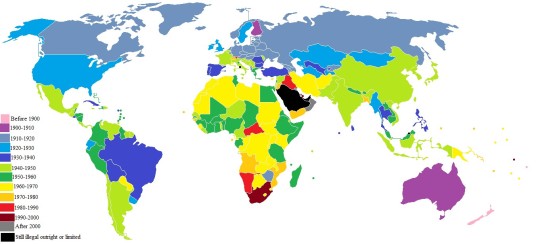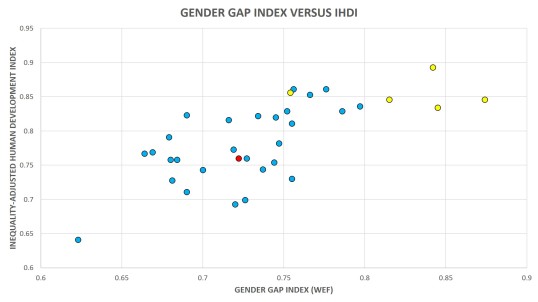Female Empowerment and Human Development, Revisited
In a previous post, I discussed the gender gap, and where we stand on gender parity within America and around the world. In the most recent World Economic Forum Global Gender Gap Report, America ranks 49th in its Gender Gap Score. What’s more, in 2006, when the WEF published its first report, America ranked 23rd. Meanwhile, France has moved from 70th place to jump far ahead of America and is now in 11th place. America is now behind 22 European countries in its Gender Gap Score.

But as I pointed out, this is not because American women are poorly educated. In fact, America is second to none in its education of women, and is ahead of most of Europe in educational gender parity. The main reason America has lost its standing has to do with political empowerment. While other countries have moved ahead, some briskly, in placing women in positions of power, America has made little progress. The WEF produces a political empowerment (for women) score for each country. On THIS score, AMERICA RANKS 96th, having fallen from the rank of 66th in 2006. It ranks below Mexico and Nicaragua. It ranks below Venezuela and Cuba. It ranks below Kenya and Zimbabwe. It ranks below India and Bangladesh. It ranks below China and South Korea.
Why? Why does America rank so low in female empowerment? Well, the WEF breaks down empowerment into 3 criteria: 1) women in parliament (or other national legislature) in relation to men; 2) women in ministerial positions in relation to men; 3) number of the last 50 years with a female head of state. Obviously, America gets a zero on this last item. But that’s not fatal in and of itself – Sweden has also never had a female head of state, yet ranks 5th in the world in its Gender Gap Score. It’s the other 2 items that really hurt us. America ranks 85th on women in parliament and 84th on women in ministerial positions. And Sweden? It ranks 6th on women in parliament and ties for NUMBER 1 on women in ministerial positions – with more women than men in these positions of power!

Why are there so few American women in top positions of power? And conversely, why are there so MANY European women in those positions? Well first of all, it’s important to realize that huge numbers of America women are out of the work force, or have only part-time jobs. America ranks 57th in labor force participation by women. Sweden ranks 12th. America’s female labor participation rate is only 66%, to Sweden’s 80%. How many politicians do you know, male or female, who run for office describing their qualifications as “I did housework and shopped”? It stands to reason that people vote for candidates with job experience, especially managerial experience. But a third of American women have little or none.

Second of all, there is religion, particularly a certain variety of religion, that is pervasive in America, and much less so in Europe, particularly western Europe. Political scientists Ronald Inglehart and Christian Welzel have developed a cultural map of the world, based on 2 major cultural dimensions: 1) traditional/authoritarian values versus secular/rational values; 2) survival values versus self-expression values. When it comes to the first dimension, America is quite different from western Europe. Western European countries like Sweden, Denmark, and Germany emphasize secular/rational values, while America is more like eastern Europe (Poland and Romania for example) in its attachment to fundamentalist religion. This has everything to do with gender roles, and consequently, female empowerment.
If we look at female labor participation rates versus the WEF’s female empowerment rating, for European countries plus America, we get this:

There is a clear relationship. The yellow dots are the 5 Scandinavian countries. The blue dot in the lower left is Turkey. Only 39% of professionals and technical workers in Turkey are women. Only 15% of the parliament consists of women, and a mere 4% of ministerial positions are held by women. Remarkably, Turkey has had a female Prime Minister, but that was back in the 1990’s and she only served for 3 years. 99.8% of the country’s citizens are AUTOMATICALLY registered as Muslims. All public schools have mandatory religion classes focusing on Sunni Islam. The red dot is America, which is similar to eastern European countries like Croatia and Poland in its female labor participation rate and female empowerment rating. It is not nearly as religious as Turkey, but much more so than most of western Europe.
But there is another element that sets America apart from much of western Europe. America is a very young country, with a recent frontier. The mythos surrounding this frontier is to this day deeply embedded in the American psyche. The cowboy caricature of masculinity, with its glorification of physical prowess, is seen time and again in American culture, even in contexts that have no apparent connection to the American West. But Europe has no memory of a recent frontier, no mythos of the rugged individual who is unmistakably male, and a particular variety of male at that.

No sooner had that frontier been settled than America quickly transitioned to an industrial powerhouse. This history very much encouraged traditional gender roles – physical strength was valued in the steel mills and oil fields, and the good wages enabled a single breadwinner to support his family. But the industrial revolution arrived much later in Scandinavia. By the time it did, female empowerment was well underway.
The industrial revolution started in Great Britain in the 18th century. But for more than a century, industrialization was slow in coming to other parts of Europe. While America was rapidly industrializing in the late 19th and early 20th centuries, much of Europe remained agrarian. Yet this was a time of worldwide progressive reform. Labor unions were asserting themselves. Compulsory education was spreading like wildfire. It is no coincidence that compulsory education was introduced early in countries like Denmark, Sweden, and Finland – the very countries that today strongly emphasize secular/rational values, and occupy top-ranking positons on gender parity and human development.

Nor is it coincidence that such countries were at the vanguard of the women’s right movements of the Progressive Era. Women won the right to vote in Finland in 1906, 14 years before the same was achieved in America. Yet Finland was largely an agrarian country right up until the 1930’s. Of course, industrialization eventually arrived in Finland, as it did across Europe. But by this time, labor unions were quite strong, the population was well educated, and women had achieved tremendous political power. Today the country is a high-tech powerhouse with less than a 3% difference in the labor participation rate of men versus women. More professional and technical workers are female than male.
Within Europe, the patterns are clear. The Scandinavian countries tend to rank at the top on both gender parity and human development. Countries that rank lower on gender parity also tend to rank lower on human development. The Inequality-adjusted Human Development Index, which does NOT take into account gender parity, is a measure of the well-being of a typical person in a given country. Yet the IHDI is well-correlated with the WEF’s Gender Gap Index. In all 5 of the Scandinavian countries, women won the right to vote before 1920. By contrast, women’s suffrage had to wait until 1945 in Italy, and 1952 in Greece. To this day, Italy and Greece lag behind Scandinavia in gender parity and human development. Formerly communist Estonia, which achieved women’s suffrage in 1918, now ranks well ahead of Italy and Greece in both gender parity and human development. If we plot the Gender Gap score by country versus the IHDI, looking at just Europe and America, we get this:

Again, the yellow countries are the 5 Scandinavian countries. The red country is America. And the country in the lower left, with the worst IHDI in Europe, is Turkey, which ranks 131st in the world in its Gender Gap Index.
The grip of Sunni Islam on Turkey is only the most extreme example of a phenomenon seen in eastern and southern Europe. In some countries it is fundamentalist Catholicism, in others the Orthodox church. In countries where religious fundamentalism plays an important role, traditional gender roles tend to stifle female empowerment. Take Poland, for example, which was formerly in the grip of Soviet communism. Yet 88% of the country is Roman Catholic. In a survey taken in 2015, 40% of Poles reported that they were “believers following the Church’s laws.” The female labor participation rate is only 62%. The parliament contains only 28% women, and women occupy only 23% of ministerial positions. Poland ranks 23rd among European countries in its IHDI.

Meanwhile, in Finland, not far to the north of Poland, a mere 8% of people describe themselves as “highly religious,” while a whopping 57% say they are either “agnostic” or “non-religious.” 42% of the Finnish parliament consists of women. 39% of ministerial positions are held by women. And Finland has had a female head of state for about a quarter of the time over the last half-century. Finland ranks 9th in Europe on the IHDI, and 5th in Europe (and the world) on the Sustainable Solution Network’s Happiness Index.
European countries with high IHDI values, such as Norway, Finland, Denmark, and the Netherlands, tend to have high Gender Gap Scores. Countries with lower IHDI values, such as Turkey, Italy, and Portugal, tend to have lower Gender Gap Scores. Female empowerment tends to produce economic wealth, better education, and improved health. For everyone. Countries that rank highly on both the “secular-rational” scale and the “self-expression” scale tend to be prosperous, have strong social safety nets, have lots of women in power, and rank highly on the global Happiness Index. The Scandinavian countries are the epitome of this.

These relationships apply across the globe. Countries that rank highly in both “traditional values” and “survival values,” such as Zimbabwe and Jordan, tend to have few women in positions of power and poor human development in general. There are some poor countries that have good gender parity, such as Rwanda and Namibia. But like much of the third world, these countries suffer from a weak rule of law and lots of government corruption, which keeps many people, male and female, poor and powerless.
The world as a whole is gradually moving in the direction of female empowerment, and that includes America. But much of Europe is passing America by at the moment. It is quite possible that we will soon see a “lurch forward” in America, as young women become strongly motivated to take political action. But it’s sad, and in a way pathetic, to see the resistance to inevitable change that merely delays progress and elicits unnecessary weeping and gnashing of teeth.

As automation accelerates, it is very likely that jobs in manufacturing, resource extraction, and cargo transportation will continue to disappear. The world will become more and more interconnected. In the first world, the jobs of the future will be all about social interaction. In other words, the traits that qualify people for most jobs in the future will likely be people skills we tend to associate with women – strong empathy, a skill at conflict resolution, plenty of emotional intelligence. The world of the future will be all about service and interdependence. In such a world, women have a distinct advantage.
